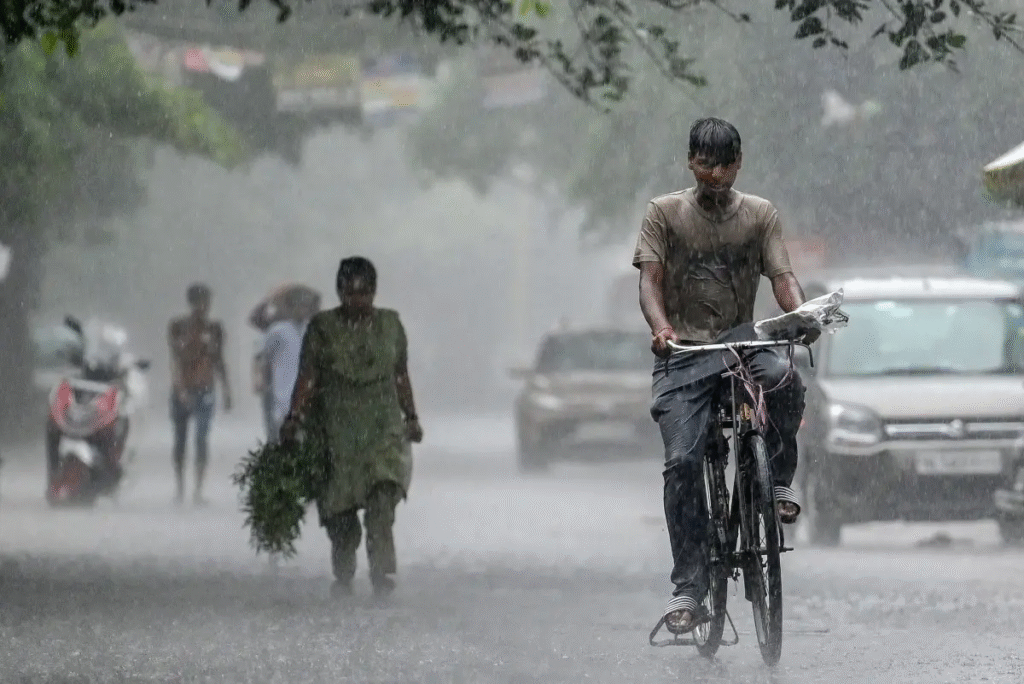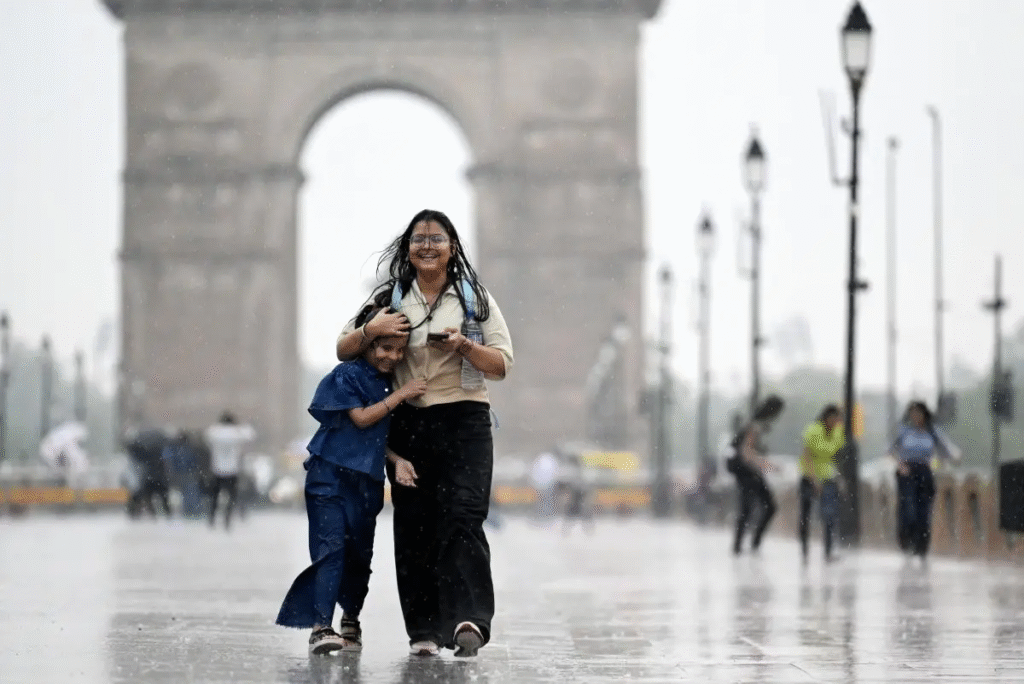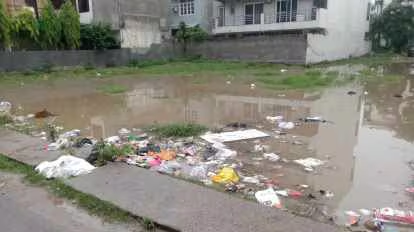Delhi-NCR Lashed by 120mm Rain in Hours: IMD Issues Red Alert, Flood Risk Soars
Delhi rain today, Delhi-NCR heavy rain: The areas that received the highest amount of rainfall till 8.30 am are Ayanagar (57.4 mm), Palam (49.4 mm), Mayur Vihar (17.5 mm) and Ridge (17.4mm)
Heavy rain lashed Delhi and parts of NCR Thursday morning, prompting the India Meteorological Department (IMD) to issue a red alert on Thursday.
According to IMD data, rain started around 2 am and continued well into the morning.
The areas that received the highest amount of rainfall till 8.30 am are Ayanagar (57.4 mm), Palam (49.4 mm), Mayur Vihar (17.5 mm) and Ridge (17.4mm).
As per the forecast, the city is expected to receive light to moderate rain during the day.
Thunderstorms and lightning, with wind speed of up to 40 kilometres per hour per hour, are expected in New Delhi, Southwest Delhi, South Delhi, Southeast Delhi.

A walkathon organised by the Delhi government from Rouse Avenue to Connaught Place ahead of the 79th Independence Day celebrations was cancelled due to the heavy rain.
In Delhi, waterlogging was seen on Outer Ring Road in Subroto Park, slowing down movement of vehicles. It also caused a severe traffic jam on Rao Tula Ram Marg.
Issuing an advisory, the Delhi Traffic Police said:
“Due to the recent rains causing waterlogging at GTK Depot, Jahangirpuri, and Adarsh Nagar, traffic on old GT Road is likely to be severely affected. Commuters are advised to avoid taking old GT Road.”
“Traffic is affected on Ring Road in the carriageway from Ashram towards Moolchand due to breakdown of MGV near Nehru Nagar,” it added
Gurgaon, meanwhile, saw 44 mm of rain till 8 am, as per data shared by the district administration.
Neighbourhoods like Palam Vihar, Ashok Vihar Phase 3 and Sector 23A saw instances of moderate to heavy waterlogging.
“It is a very bad situation. The main roads and even the parks are totally inundated. And there is a health crisis now because the garbage lying in open plots is floating,” said Sector 23 Residents’ Development and Welfare Association general secretary Bhawani Shankar Tripathy.
The garbage amidst the water-logging poses risks of water-borne and vector-borne diseases, he added, stating that it is a health crime by the civic body.
Gurugram Metropolitan Development Authority individuals said gullies along all roads are being cleaned expeditiously, and additional pump sets will be deployed in areas the issue persists in.

A municipal corporation official said workers have been deployed in affected areas.
The minimum temperature in Delhi was recorded as 23.6 degrees Celsius, three degrees below normal.
Issuing a red alert IMD forecast the following impact and measures:
Impact expected:
– Localized flooding of roads, waterlogging in low lying areas and closure of underpasses.
-Occasional reduction in visibility due to heavy rainfall.
-Disruption of traffic in some areas due to water logging in roads leading to increased travel time.
-Traffic congestion and slippery roads due to heavy rain spell and water logging.
-Routine outdoor business/activity very likely to affect.
-Damage to plantation, horticulture and standing crops.
-Partial damage to vulnerable structures.
-Minor damage to kutcha houses/walls and huts.
Residents of Delhi-NCR woke up to pounding rain on Thursday morning, as a powerful monsoon system unleashed over 120mm of rainfall within just a few hours, turning streets into streams and sparking urgent flood warnings. The India Meteorological Department (IMD) has issued a red alert for the region, warning of heavy to very heavy rain for the next 24 hours and urging citizens to stay indoors unless absolutely necessary.
The rain began in the early hours, intensifying around dawn. By 8 a.m., traffic had come to a near standstill on several major routes, including the Delhi–Gurugram Expressway, Ring Road, and Noida Link Road. Visuals from across the city showed waterlogged underpasses, stranded vehicles, and commuters wading through knee-deep water.
Public transport services also felt the impact. Several Delhi Metro lines experienced slower operations due to waterlogging near entry points in low-lying stations, while buses were diverted from flooded routes.
A red alert is the IMD’s highest warning level, signalling that extremely heavy rainfall is very likely and could cause major disruption to daily life, property, and infrastructure. According to IMD officials:
“Delhi-NCR is under the influence of a strong monsoon trough coupled with a cyclonic circulation over northwest India. This combination is driving intense rain bands into the region.”
The alert covers Delhi, Noida, Gurugram, Ghaziabad, and Faridabad, with forecasts predicting rainfall between 115mm and 204mm in some areas. Authorities have also cautioned about the possibility of urban flooding, traffic jams, and tree falls.
Municipal authorities in Delhi and adjoining NCR cities have activated emergency teams to clear clogged drains and pump out water from flooded streets. Disaster management control rooms are on high alert, and the Delhi Traffic Police has issued advisories urging commuters to avoid waterlogged stretches.
Hospitals have been asked to prepare for potential monsoon-related medical cases, including waterborne diseases and accidents. Power distribution companies have also deployed extra crews to manage potential outages caused by the weather.
Officials have urged residents to:
Stay indoors unless travel is unavoidable.
Avoid going near overflowing drains or waterlogged underpasses.
Monitor weather updates from IMD and local authorities.
Ensure proper drainage around residential areas to prevent water accumulation.
Schools in parts of Gurugram and Noida have declared a day off or shifted to online classes due to the weather.
The intense rain has disrupted office commutes, with many companies opting to allow employees to work from home. Delivery services have been delayed, and several markets in low-lying areas have remained shut for the day. Experts warn that if the rain continues at this pace, it could lead to a significant short-term economic impact due to business closures and transportation bottlenecks.








